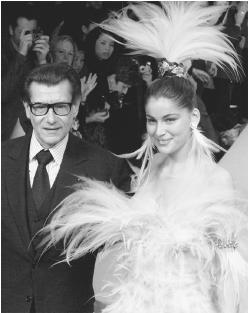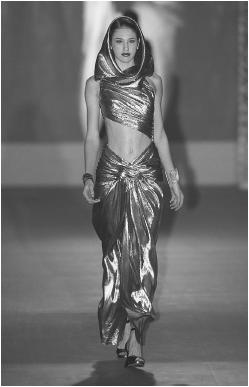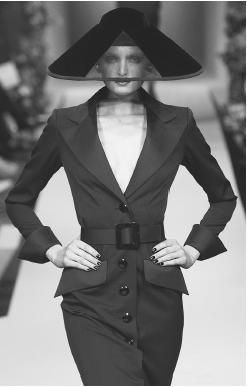Yves Saint Laurent - Fashion Designer Encyclopedia
French designer
Born: Yves Henri Donat Mathieu Saint Laurent in Oran, Algeria, 1 August 1936. Education: Studied at L'École de la Chambre Syndicale de la Couture, 1954. Career: Independent clothing stylist, Paris, 1953-54; designer/partner, 1954-57, chief designer, Dior, Paris, 1957-60; began designing for theater and film, 1959; founder/designer, Yves Saint Laurent, Paris, from 1962; Rive Gauche ready-to-wear line introduced, 1966; menswear line introduced, 1974; firm purchased by Elf-Sanofi SA, 1993; designer Elber Albaz hired, 1998-2000; acquired by Gucci Group NV, 1999; Tom Ford took over as creative director, 2000; renovated Madison Avenue store reopened, 2001; retired from designing, 2002; fragrances include Y 1964; Rive Gauche, 1971; Opium, 1978; Paris, 1983; Champagne, (renamed Yvresse, 1996) 1993; Opium relaunch, 1995; Opium for Men, 1996; Baby Doll, 1999; Nu, 2001. Exhibitions: Yves Saint Laurent, Metropolitan Museum of Art, 1983; Yves Saint Laurent et le Théâtre, Musée des Arts de la Mode, Paris, 1986; Yves Saint Laurent, 28 Ans de Création, Musée des Arts de la Mode, 1986; retrospective, Art Gallery of New South Wales, Sydney, Australia, 1987. Awards: International Wool Secretariat award, 1954; Neiman Marcus award, 1958; Harper's Bazaar award, 1966; Council of Fashion Designers of America award, 1981; CFDA Lifetime Achievement award, 1999; Fifi Fragrance award (for Baby Doll ), 2000. Address: 5 avenue Marceau, 75116 Paris, France. Website: www.yslonline.com .

Publications
By SAINT LAURENT:
Books
Yves Saint Laurent, New York & London, 1984.
Yves Saint Laurent par Yves Saint Laurent, Paris, 1986.
Bergé, Pierre, and Yves Saint Laurent, Yves Saint Laurent, London & New York, 1996, 1997.
Yves Saint Laurent: Forty Years of Creation, New York, 1998.
Love, by Yves Saint Laurent, New York, 2000.
On SAINT LAURENT:
Books
Lynam, Ruth, ed., Couture: An Illustrated History of the Great Paris Designers and Their Creations, New York, 1972.
Madsen, Axel, Living for Design: The Yves Saint Laurent Story, New York, 1979.
Milbank, Caroline Rennolds, Couture: The Great Designers, New York, 1985.
Musée des Arts Décoratifs, Yves Saint Laurent et le Théâtre [exhibition catalogue], Paris, 1986.
Art Gallery of New South Wales, Yves Saint Laurent, Retrospectives [exhibition catalogue], Sydney, New South Wales, 1987.
Perschetz, Lois, ed., W, The Designing Life, New York, 1987.
Yves Saint Laurent: Images of Design [exhibition catalogue], New York, 1988.
Howell, Georgina, Sultans of Style: 30 Years of Fashion and Passion 1960-1990, London, 1990.
Benaïm, Laurence, Yves Saint Laurent, Paris, 1993, 1995.
Martin, Richard, and Harold Koda, Orientalism: Visions of the East in Western Dress [exhibition catalogue], Metropolitan Museum of Art, 1994.
Stegemeyer, Anne, Who's Who in Fashion, Third Edition, New York, 1996.
Rawsthorn, Alice, Yves Saint Laurent, A Biography, London, 1996, 1997.
Duras, Marguerite, Yves Saint Laurent and Fashion Photography, Munich, 1998.
Tierney, Tom, Yves Saint Laurent Fashion Review, Mineola, New York, 1999.
Articles
"YSL Models Rive Gauche for Men in His Marrakesh Home," in Vogue (London), 1 October 1969.
"Yves Saint Laurent: His Very Special World," in McCall's (New York), January 1970.
"Mary Russell Interviews Saint Laurent," in Vogue (New York), 1 November 1972.
"Yves Saint Laurent Talks to Bianca Jagger," in Interview, January 1973.
Julian, P., "Les années 20 revues dans les années 70 chez Yves Saint Laurent," in Connaissance des Arts (Paris), December 1973.
Heilpern, John, and Yves Saint Laurent, "Yves Saint Laurent Lives," in The Observer Magazine (London), 5 June 1977.
"Designers of Influence: Yves Saint Laurent, the Great Educator," in Vogue (London), June 1978.
"Bravo: 20 Years of Saint Laurent," in Vogue (London), April 1982.

"A Salute to Yves Saint Laurent," in the New York Times Magazine, 4 December 1983.
Brubach, Holly, "The Truth in Fiction," in The Atlantic Monthly (Boston, Massachusetts), May 1984.
Savage, Percy, "Yves Saint Laurent," in Art and Design (London), August 1985.
Berge, P., "Yves Saint Laurent der Modezeichner," in Du (Zurich), No. 10, 1986.
"Un équilibre définitif: Saint Laurent Rive Gauche ," in Vogue (Paris), February 1986.
Griggs, Barbara, "All About Yves," in The Observer (London), 25 May 1986.
Mauries, Patrick, "Yves," in Vogue (Paris), June 1986.
"Le triomphe de Saint Laurent," in L'Officiel (Paris), June 1986.
Pringle, Colombe, "Saint Laurent: sanctifié il entre au musée," in Elle (Paris), June 1986.
Worthington, Christa, "Saint Laurent: Life as a Legend," in Women's Wear Daily (New York), 18 July 1986.
"Yves Only," in Vogue (London), September 1987.
"Prince Charmant. Bernard Sanz: L'homme de Saint Laurent," in Profession Textile (Paris), 27 May 1988.
"Saint Laurent pour toujours," in Profession Textile (Paris), 30 September 1988.
Duras, Marguerite, "Saint Laurent par Duras," in Elle (Paris), 31 October 1988.
Hyde, Nina, and Albert Allart, "The Business of Chic," in the National Geographic (Washington, D.C.), July 1989.
Howell, Georgina, "The Secrets of Saint Laurent," in The Sunday Times Magazine (London), 2 July 1989.
——, "Best Couturier: Yves Saint Laurent," in The Sunday Times Magazine (London), 16 July 1989.
Rafferty, Diane, Charles van Rensselaer and Thomas Cunneen, "The Many Faces of Yves: The Designer of the Half Century," in Connoisseur, February 1990.
Menkes, Suzy, "Yves of the Revolution," in the Sunday Express Magazine (London), 22 April 1990.
Germain, Stephanie, "All About Yves," in Paris Passion (Paris), October 1990.
Roberts, Michael, and André Leon Talley, "Unveiling Saint Laurent," in Interview (New York), June 1991.
Smith, Liz, "Thirty Years at Fashion's Cutting Edge," in The Times (London), 27 January 1992.
"Yves Saint Laurent, King of Couture," interview, in Elle (New York), February 1992.
Brubach, Holly, "Fanfare in a Minor Key," in The New Yorker, 24 February 1992.
White, Lesley, "The Saint," in Vogue (London), November 1994.
Kramer, Jane, "The Impresario's Last Act, in the New Yorker (New York), 21 November 1994.
Schiro, Anne-Marie, "Yves Saint Laurent's Shocking New Color: Black," in the New York Times (New York), 22 March 1995.
Menkes, Suzy, "YSL Plays Safe While Valentino Shines at Night," in the International Herald Tribune (Paris), 22 March 1995.
"Saint Laurent: A Fitting End," in WWD, 22 March 1995.
Menkes, Suzy, "A New Generation in Ready-to-Wear: Alber Elbaz Gets Aboard at YSL," in the International Herald Tribune, 9 June 1998.
"YSL Coming to Receive CFDA Award," in WWD, 29 March 1999.
Menkes, Suzy, "Gucci Buys House of YSL for $1-Billion," in the International Herald Tribune, 16 November 1999.
——, "New Team, Same Theme at YSL," in the International Herald Tribune, 20 January 2000.
Socha, Miles, "Ford's YSL: Full Steam Ahead," in WWD, 12 January 2001.
"At Yves Saint Laurent, Tom's Triumph," in WWD, 15 March 2001.
Menkes, Suzy, "YSL and the Secrets of Classic Couture," in the International Herald Tribune, 12 July 2001.
Ozzard, Janet, "Tom's Rive Gauche," in WWD, 6 September 2001.
Ozzard, Janet, et al, "Tom Ford Expands YSL Store," in DNR, 10 September 2001.
Diderich, Joelle, "Fashion Legend Yves Saint Laurent Retires," from Reuters Newswire, 7 January 2002.
Cowdy, Hannah, "YSL: Adieu to a Fashion Generation," available online at ABCNews, www.ABCNews.com , 7 January 2002.
***
A great adaptor, Yves Saint Laurent responds in his designs to history, art, and literature. Vast ranges of themes are incorporated into his work, from the Ballet Russes to the writings of Marcel Proust, who inspired his taffeta gowns of 1971; the paintings of Picasso to the

Saint Laurent has a great love of the theatre. He has designed costumes for many stage productions during his long career and the theatre is an important source of ideas for his couture collections. Flamboyant ensembles, such as the Shakespeare wedding dress of brocade and damask of 1980 and his extravagant series of garments inspired by a romantic vision of Russian dress, reflect his passion for theatrical costume.
Less successful have been his attempts to engage with countercultural movements such as the 1960 collection based on the bohemian Left Bank look. The criticism leveled by the press on being confronted with the avant garde on the couture catwalk led to Saint Laurent's replacement as head designer for Dior, even though his 1958 trapeze line had been an enormous success and he had been fêted as the savior of Parisian couture. At this time the House of Dior was responsible for nearly half of France's fashion exports, so there was a heavy burden of financial responsibility on Saint Laurent's shoulders.
The 1960 collection appropriated the Left Bank style with knitted turtlenecks and black leather jackets, crocodile jackets with mink collars, and—a design which was to crop up again and again in his repertoire—the fur jacket with knitted sleeves. In 1968 Saint Laurent produced a tailored trouser collection reflecting his sympathy with the cause of the student marchers who had brought the streets of Paris to a standstill. The clothes were black and accessorized with headbands and fringes.
Where Saint Laurent sets the standards for world fashion is in his feminizing of the basic shapes of the male wardrobe. Like Chanel before him, he responded to the subtleties of masculine tailoring seeking to provide a similar sort of style for women. He produced a whole series of elegant day clothes, such as the shirt dress, which became a staple of the sophisticated woman's wardrobe of the 1970s. Saint Laurent is justly acclaimed for his sharply tailored suits with skirts or trousers, le smoking (a simple black suit with satin lapels based on the male tuxedo, which became an alternative to the frothily feminine evening gown), safari jackets, brass buttoned pea jackets, flying suits—in fact many of the chic classics of postwar women's style.
Saint Laurent's designs contain no rigid shaping or over-elaborate cutting but depend on a perfection of line and a masterful understanding of printed textiles and the use of luxurious materials. He worked with silk printers to produce glowing fabric designs incorporating a brilliant palette of clashing colors such as hot pink, violet, and sapphire blue. A sharp contrast is produced with his simple, practical daywear and romantic, exotic eveningwear, which is more obviously seductive with its extensive beadwork, embroidery, satin, and sheer fabrics such as silk chiffon.
Less interested in fashion than in style, Saint Laurent is and will always be a classicist, designing elegant, tasteful, and sophisticated apparel, perfectly handcrafted in the manner of the old couturiers. He did, however, use industrial methods to produce his Rive Gauche ready-to-wear line, created in 1966, and sold in his own franchised chain of boutiques. The popular line was later taken over by Alber Elbaz, who had worked for Guy Laroche, in 1998, and then by Tom Ford in 2000.
There was been a radical change in the small company founded by Yves Saint Laurent and business partner Pierre Bergé in 1961. It became a massive financial conglomerate, listed on the Paris Bourse, the result of profitable licensing deals. In the 1990s the firm changed ownership several times, ending up as part of the Gucci Group in 1999. Called "fashion's shiniest trophy," by the International Herald Tribune (16 November 1999), the YSL acquisition was another example of the fashion industry's tightening consolidation.
In the 21st century, YSL remained an acclaimed couture house, though its namesake and Rive Gauche designer Tom Ford rarely saw eye to eye. In January 2002, however, such creative differences were moot: Saint Laurent announced he was leaving the firm that bore his name and retiring. Roundly considered the last of the true haute couturiers, the industry lost one of its most elegant and inspired purveyors.
—Caroline Cox;
updated by Nelly Rhodes
Comment about this article, ask questions, or add new information about this topic: